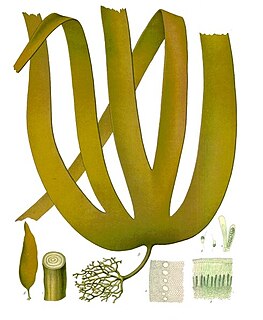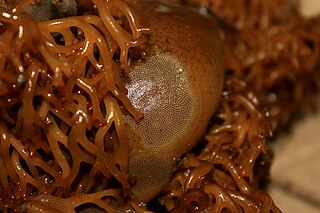
Kelps are large brown algae seaweeds that make up the order Laminariales. There are about 30 different genera. Despite its appearance, kelp is not a plant; it is a heterokont.

The brown algae, comprising the class Phaeophyceae, are a large group of multicellular algae, including many seaweeds located in colder waters within the Northern Hemisphere. Most brown algae live in marine environments, where they play an important role both as food and as a potential habitat. For instance, Macrocystis, a kelp of the order Laminariales, may reach 60 m (200 ft) in length and forms prominent underwater kelp forests. Kelp forests like these contain a high level of biodiversity. Another example is Sargassum, which creates unique floating mats of seaweed in the tropical waters of the Sargasso Sea that serve as the habitats for many species. Many brown algae, such as members of the order Fucales, commonly grow along rocky seashores. Some members of the class, such as kelps, are used by humans as food.

Lessoniaceae are a family of kelp. Species of this family have transition zone with intercalary meristem subdivided so that there are a number of secondary stipes in addition to the primary stipe.

Nereocystis is a monotypic genus of kelp containing the species Nereocystis luetkeana. Some English names include edible kelp, bull kelp, bullwhip kelp, ribbon kelp, bladder wrack, and variations of these names. Due to the English name, bull kelp can be confused with southern bull kelps, which are found in the Southern Hemisphere. Nereocystis luetkeana forms thick beds on rocks, and is an important part of kelp forests.

Alariaceae are a family of brown algae in the order Laminariales.

Laminariaceae is a family of brown algal seaweeds, many genera of which are popularly called "kelp". The table indicates the genera within this family. The family includes the largest known seaweeds: Nereocystis and Macrocystis.

Macrocystis is a monospecific genus of kelp. This genus contains the largest of all the phaeophyceae or brown algae. Macrocystis has pneumatocysts at the base of its blades. Sporophytes are perennial and the individual may live for up to three years; stipes/fronds within a whole individual undergo senescence, where each frond may persist for approximately 100 days. The genus is found widely in subtropical, temperate, and sub-Antarctic oceans of the Southern Hemisphere and in the northeast Pacific from Baja California to Sitka, Alaska. Macrocystis is often a major component of temperate kelp forests.

Lessonia is a genus of large kelp native to the southern Pacific Ocean. It is restricted to the southern hemisphere and is distributed along the coasts of South America, New Zealand, Tasmania, and the Antarctic islands. The genus was first described by Jean Baptiste Bory de Saint-Vincent in 1825.

Alaria is a genus of brown alga (Phaeophyceae) comprising approximately 17 species. Members of the genus are dried and eaten as a food in Western Europe, China, Korea, Japan, and South America. Distribution of the genus is a marker for climate change, as it relates to oceanic temperatures.

Durvillaea antarctica, also known as cochayuyo and rimurapa, is a large, robust species of southern bull kelp found on the coasts of Chile, southern New Zealand, and Macquarie Island. D. antarctica, an alga, does not have air bladders, but floats due to a unique honeycomb structure within the alga's blades, which also helps the kelp avoid being damaged by the strong waves.

Durvillaea willana is a large species of southern bull kelp endemic to New Zealand.

Saccharina latissima is a brown algae, of the family Laminariaceae. It is known by the common name sugar kelp, and also sea belt and Devil's apron, due to its shape. It is found in the north east Atlantic Ocean, the Pacific Ocean and the Barents Sea south to Galicia in Spain. It is not found in the Bay of Biscay but is common round the coasts of the British Isles. The species is found at sheltered rocky seabeds.

Macrocystis pyrifera, commonly known as giant kelp or giant bladder kelp, is a species of kelp, and one of four species in the genus Macrocystis. Despite its appearance, it is not a plant; it is a heterokont. Giant kelp is common along the coast of the eastern Pacific Ocean, from Baja California north to southeast Alaska, and is also found in the southern oceans near South America, South Africa, Australia, and New Zealand. Individual algae may grow to more than 45 metres long at a rate of as much as 60 cm (2 ft) per day. Giant kelp grows in dense stands known as kelp forests, which are home to many marine animals that depend on the algae for food or shelter. The primary commercial product obtained from giant kelp is alginate, but humans also harvest this species on a limited basis for use directly as food, as it is rich in iodine, potassium, and other minerals. It can be used in cooking in many of the ways other sea vegetables are used, and particularly serves to add flavor to bean dishes.

Aquaculture of giant kelp, Macrocystis pyrifera, is the cultivation of kelp for uses such as food, dietary supplements or potash. Giant kelp contains compounds such as iodine, potassium, other minerals vitamins and carbohydrates.

Macrocystis integrifolia is one of four species of kelp in the genus Macrocystis which grows to about 6 metres (20 ft) long.

Durvillaea poha is a large, robust species of southern bull kelp found in New Zealand.
Durvillaea amatheiae is a large, robust species of southern bull kelp found in Australia.

Durvillaea fenestrata is a large, robust species of southern bull kelp endemic to the subantarctic Antipodes Islands of New Zealand.

Durvillaea fenestrata is a large, robust species of southern bull kelp endemic to the subantarctic Antipodes Islands of New Zealand.

Laminaria nigripes is a species of kelp found in the North Atlantic and North Pacific within Arctic and subarctic waters including Vancouver Island, Haida Gawaii, Greenland, Iceland, Norway, Downeast Maine, and the Bay of Fundy. The species may be found exclusively in the Arctic, but frequent misidentification of samples has led to speculation and debate over whether the actual range is subarctic or Arctic. The species is commonly confused with Laminaria digitata and Laminaria hyperborea and is at risk from climate change.


















